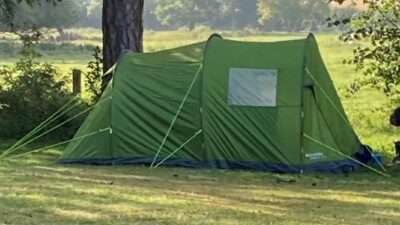This post contains affiliate links.
When buying our first tent, I was not aware of the difference between double and single-walled tents.
Buying the right tent suitable for your camping trip is essential as you do not want to buy the wrong tent and feel like we have wasted our money, especially if you are considering spending over £500 on one single item.
Double-walled tents consist of a main inner breathable tent, poles are on the outside and overlays and clips onto the tent poles—both inner and rainfly need to be pegged separately. Single tents are one wall of breathable water-proof fabric. It is important to consider the pros and cons of each design.
What you need to consider when selecting your tent
It’s important to select the correct tent and consider if your tent is for a 1-night or for more or just for yourself, yourself, and your family. Also, consider the occasion that you will be using your tent for, such as:
- Family holiday
- Quick overnight camping trip
- Festival
- Wild camping
- Backpacking
- How many people will be sleeping in the tent
- Location
- Outside temperatures
The above needs to be considered as this will help you decide on the single or double-walled and design of your tent.
Pros and cons of double and single-walled tents
| Double-walled tents | Single-walled tents | ||
|---|---|---|---|
| Pros | Cons | Pros | Cons |
| Inside of your tent will be dry | Heavier than single-walled tents | Easier to pitch as only one tent shell | Weak in heavy rain and wind |
| Multiple doors | It can be challenging to pack | Easier to pack as only one tent shell and poles | Increase in condensation |
| Less condensation build-up | If very windy, it can be challenging to pitch rainfly | Lighter to carry | Ventilation vents must be kept open to reduce condensation, which will feel colder inside of your tent |
| The inner tent is breathable | More pegging is required due to two separate layers | Ideal for festivals and backpacking | Sagging due to moisture build up on the outside of your tent |
| If raining when pitching, the inside of the tent can be kept dry | May need to adjust rainfly to keep pegged correctly | Suitable for family camping | No suitable for backpacking, mountaineering or festivals |
| More protection against heavy rain and wind | More expensive | Tents have larger foot prints | |
| No vents to allow warm air from escaping | Cheaper than double walled tents | ||
| Can removed the rainfly |
Why double-wall tents warmer in the winter and cooler in the summer?

Double-walled tents are warmer because you have two layers, the inner breathable tent and the rainfly, which is water-proof. The warm air is trapped between the two layers that create a warm bubble around the inner tent.
This also works in opposite weather conditions; double-walled tents are cooler in the summer. This may seem odd, but the cooler air is trapped inside the two layers, therefore deflecting the heat and allowing the inner tent to remain cool. Obviously, if you are venting your double-walled tent by opening the door fully, the warmer air will heat the inside of your tent.
Why are single-walled tents colder in winter but very hot in the summer?
Single tents are cooler in the winter due to not having the additional protection of a rainfly. It is just one layer, so you are more exposed to the elements. In the summer, a single-walled tent will be warmer as the sun will be warming your tent wall directly unless you have pitched in an area that will give you natural shade.
When selecting your single-walled tent because you will not have a rainfly to provide additional protection is essential to purchase a tent with the correct HH levels, which are water-proofing resistance ratings.
Single or double-walled tents – which is best to reduce condensation?
Double-walled tents have fewer condensation issues than single-walled tents.
Double-walled tents inner layer is a breathable material, allowing air to escape, and moisture will gather on the underside of the rainfly. The condensation underneath your rainfly will drip onto the inner tent, but condensation will reduce inside the tent. So you will not wake up with damp clothes, a sleeping bag or soaking wet walls.
Single-walled tents are breathable materials; it is essential to have the vents open to allow the inner temperature to merge with the outer temperature. It would help if you ventilated your tent even during cold nights. This will reduce condensation, but it will not stop it. Single-walled tents are known for high condensation levels, leaving your walls, clothes and sleeping bags feeling very damp.
What tent has more storage – single or double-walled tents?

For instance, if you purchase a single-walled tent suitable for a family with separate sleeping and living areas, the living areas will provide additional storage. If the tent does not have a porch area, this can be purchased separately, increasing storage areas.
A double-walled tent does have limited storage areas. Depending on the design, you may have a small porch area that you can place your shoes, muddy clothes or a few bags, but not really anything else.
Double-walled tents can have a vestibule, which is incorporated into the rain fly design. The main inner tent is covered, but there is a different section of the rainfly that will extend and cover half of the entrance of your tent. There is no groundsheet, and belongings will not be protected from rain, so it is crucial to ensure that the tent is pitched facing away from wind or rain to protect your stored gear.
Are double-walled tents more expensive than single-walled tents?
Double-walled tents for casual overnight stay are cheap but they do not offer much protection and there is no living area.
Prices can vary from £50 – £300 plus, the higher the price the more protection for camping in more severe weather conditions.
Double-walled tents are not ideal for long family holiday camping holidays. We use our double-walled tent for quick overnight stays. They are ideal if you want to travel to different campsites over a short period of time. But you have to be comfortable with sitting outside and potentially getting a bit wet.
If you want to use a double-walled tent you can use a tarp, attached to bushes or trees to help provide additional cover.
Double-walled tents
| Tent | Style | Sleeps | Living area | Cost |
|---|---|---|---|---|
| VANGO Nova 200 2-Person Tent | Tunnel | 2 | No | £89 |
| VANGO Banshee Pro 300 Backpacking Tent | Tunnel | 3 | No | £185 |
| MSR ELIXIR 3 | Dome | 3 | No | £320 |
Single-walled tents
| Tent | Style | Sleeps | Living Area | Size M (L X W X H) | Cost |
|---|---|---|---|---|---|
| Eurohike Air 400 Inflatable Tent | Family tent | 4 | Yes Only 1.65 | 4.65 x 2.65 x 1.95 | £330 |
| Coleman Fast Pitch Air Valdes 4 Tent | Family Tent – Tunnel | 4 | Yes | 6.10 x 3 x 2 | £532 |
| Coleman Mosedale 5 Family 5 Person Ten | Tunnel – Family tent | 5 | Yes – 2.5m | 4.7 x 3.33 x 1.95 | £299 |
| Eurohike Rydal 500 5 Person Tent | Tunnel – Family tent | Yes – 2.35m | 4.65 x 3.2 x 2.05 | £180 |
Are single-walled tents more water-proof and double-walled tent?
Single-walled tents you would assume are not as waterproof as double-walled tents. The only difference is that the double-walled tent has two layers and the inner layer is protected against the rain by the rainfly and not directly with the inner tents itself.
The walling of single and double-walled tents are waterproofed and is rated by their HH Levels (Hydrostatic Head), which is the amount of pressure required before water leaks through your tent material.
If the waterproofing fails on a single-walled tent you will notice it more easily because you will be able to see and feel the water seeping through. Although condensation of faults in the seams are often mistaken and is condensation.
Tents can easily be waterproofed and should be waterproofed every couple of years, depending on how often you are camping.
Related questions
Which type of tent are best for family holidays – single or double-walled tents?
Single-walled tents are ideal for family holidays. They have plenty of space and the sleeping areas can be divided using blackout sleeping compartments. Most tents are sold with these included, but you can normally buy them separately if needed.
Single-walled tents are easy to pitch, but they can be awkward if you are on your own. Ideally, you need two people to help.
Can you add extra living space to your tent?
It is also possible to add an additional living area by purchasing awnings for the relevant tent. Depending on your tent the prices can range from £100 to £350.
Always check the prices of additional awnings or extensions before purchasing your tent to avoid any nasty surprises.
If you want to keep to a budget, you can buy a tarp for £40 and additional poles for £14.99 (pack of two). This is a very cheap way to added additional shelter to your tent without breaking the budget.
Do I have to buy a groundsheet for our tent if there is already a sewn-in one?
It is always recommended that you purchase a groundsheet for your tent even if you have a sewn-in one.
Pegging your groundsheet first and placing your tent on the top of your groundsheet will help to protect the underside of your tent if it is sewn-in.
The groundsheet mustn’t be sticking out of the sides of your tent as this will allow water to seep underneath your tent between the layers. This defeats the purpose of having an additional groundsheet for your tent.


